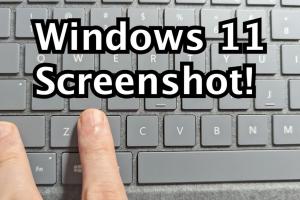Mastering Screenshots: 10 Simple Methods to Capture on Your MacBook

-
Quick Links:
- 1. Using Keyboard Shortcuts
- 2. Screenshot Toolbar in macOS Mojave and Later
- 3. Capturing a Specific Window
- 4. Taking Screenshots with Preview
- 5. Using Third-Party Applications
- 6. Taking Screenshots with Grab Utility
- 7. Setting Up Custom Keyboard Shortcuts
- 8. Saving Screenshots to Clipboard
- 9. Annotating Screenshots
- 10. Best Practices for Managing Screenshots
- FAQs
1. Using Keyboard Shortcuts
One of the quickest ways to take a screenshot on your MacBook is by using keyboard shortcuts. Here are the most common ones:
- Capture the entire screen: Press
Command (⌘) + Shift + 3. This captures everything displayed on your screen and saves it to your desktop. - Capture a selected portion: Press
Command (⌘) + Shift + 4. This allows you to drag and select the area you wish to capture. - Capture a specific window: Press
Command (⌘) + Shift + 4, then press the Spacebar. Your cursor changes to a camera icon, allowing you to click on the window you want to capture.
2. Screenshot Toolbar in macOS Mojave and Later
If you are using macOS Mojave (10.14) or later, you can access a dedicated screenshot toolbar:
- Press
Command (⌘) + Shift + 5to open the screenshot toolbar. - You will see options to capture the entire screen, a selected window, or a selected portion.
- Additionally, you can choose to record your screen directly from this toolbar.
3. Capturing a Specific Window
To capture a specific window on your MacBook:
- Press
Command (⌘) + Shift + 4to activate the selection tool. - Hit the Spacebar; your cursor will turn into a camera.
- Click on the window you want to capture, and it will be saved as a screenshot.
4. Taking Screenshots with Preview
Preview is often overlooked, but it can also be used to take screenshots:
- Open Preview from your Applications folder.
- Click on File in the menu bar, then select Take Screenshot.
- You can choose to capture the entire screen, a selected portion, or a specific window.
5. Using Third-Party Applications
For those who need advanced features, third-party applications can be a great option. Popular apps include:
- Snagit: Offers powerful editing tools and is great for professional use.
- Lightshot: A simple tool that allows quick sharing and editing of screenshots.
- Greenshot: An open-source tool that provides various capturing options and annotations.
6. Taking Screenshots with Grab Utility
Grab was the predecessor to the screenshot toolbar in Mojave. Here’s how to use it:
- Open Grab from your Applications > Utilities folder.
- Select the type of screenshot you want to take from the Capture menu.
- Follow the prompts to capture your screen.
7. Setting Up Custom Keyboard Shortcuts
Custom keyboard shortcuts can enhance your screenshot efficiency:
- Go to System Preferences > Keyboard.
- Select the Shortcuts tab, then Screen Shots.
- Here, you can customize the shortcuts according to your preference.
8. Saving Screenshots to Clipboard
Sometimes you may want to save a screenshot directly to the clipboard rather than your desktop:
- To capture the entire screen, press
Command (⌘) + Control + Shift + 3. - For a selected portion, use
Command (⌘) + Control + Shift + 4.
9. Annotating Screenshots
After taking a screenshot, you might want to annotate it:
- Open the screenshot with Preview or Photos.
- Use the markup tools to add text, shapes, or arrows.
10. Best Practices for Managing Screenshots
To manage your screenshots effectively, consider the following tips:
- Create a dedicated folder for your screenshots to keep your desktop organized.
- Regularly review and delete unnecessary screenshots.
- Use consistent naming conventions for easy retrieval.
FAQs
- How do I take a screenshot on a MacBook?
You can use keyboard shortcuts like Command + Shift + 3 for the entire screen or Command + Shift + 4 for a selected area. - Can I take a screenshot of a specific window?
Yes, use Command + Shift + 4, then press the Spacebar, and click the window you want to capture. - Are there tools for editing screenshots?
Yes, you can use Preview, third-party apps like Snagit, or online tools for editing screenshots. - How do I save a screenshot to my clipboard?
Press Command + Control + Shift + 3 or 4, depending on whether you want the entire screen or a selected area. - What is the screenshot toolbar?
The screenshot toolbar is a feature in macOS Mojave and later that allows you to take screenshots and screen recordings easily. - Can I customize screenshot shortcuts?
Yes, you can customize your screenshot shortcuts in System Preferences under Keyboard settings. - What formats can I save my screenshots in?
By default, screenshots are saved as PNG files, but you can use Preview to convert them to other formats. - How do I annotate my screenshots?
You can annotate screenshots using Preview or Photos by using the markup tools available in these applications. - Is there a way to record my screen on a MacBook?
Yes, you can record your screen using the screenshot toolbar by selecting the recording option. - What’s the best way to keep my screenshots organized?
Create a dedicated folder, use consistent naming conventions, and regularly review your files.
Random Reads
- How to clean drains
- How to clean crayon out of a dryer
- How to hang a door
- How to handle roof runoff without gutters
- How to add music to ipod
- How to add music from itunes to ipod
- How to craft a painting in minecraft
- How to insert symbols in word
- How to install a ceiling fan by yourself
- How to test for mold